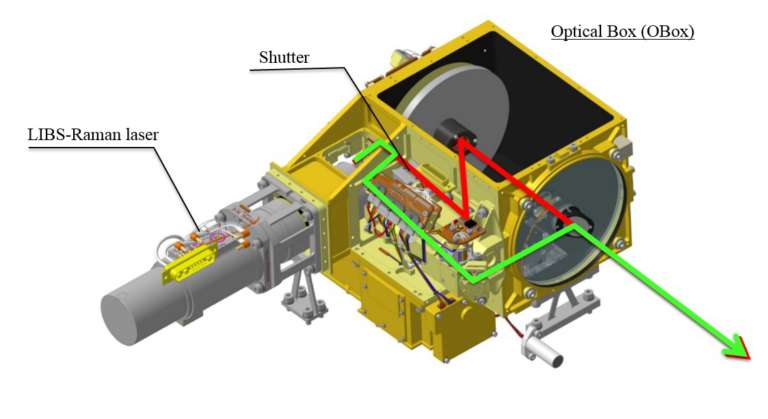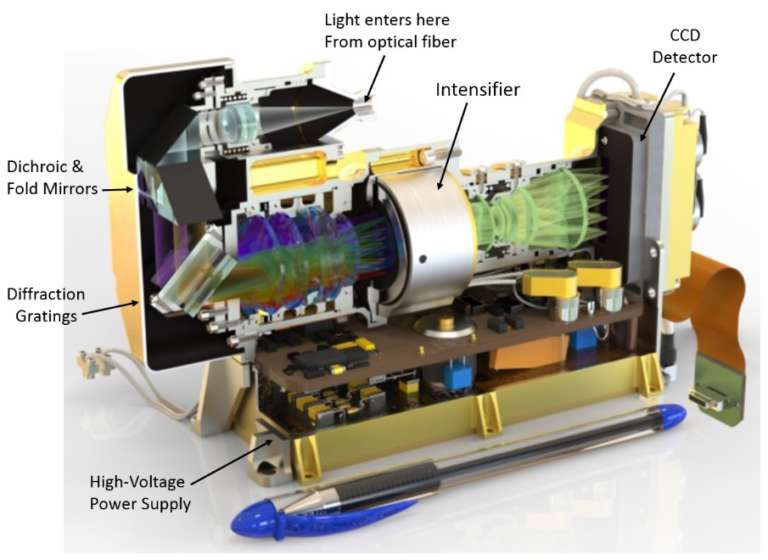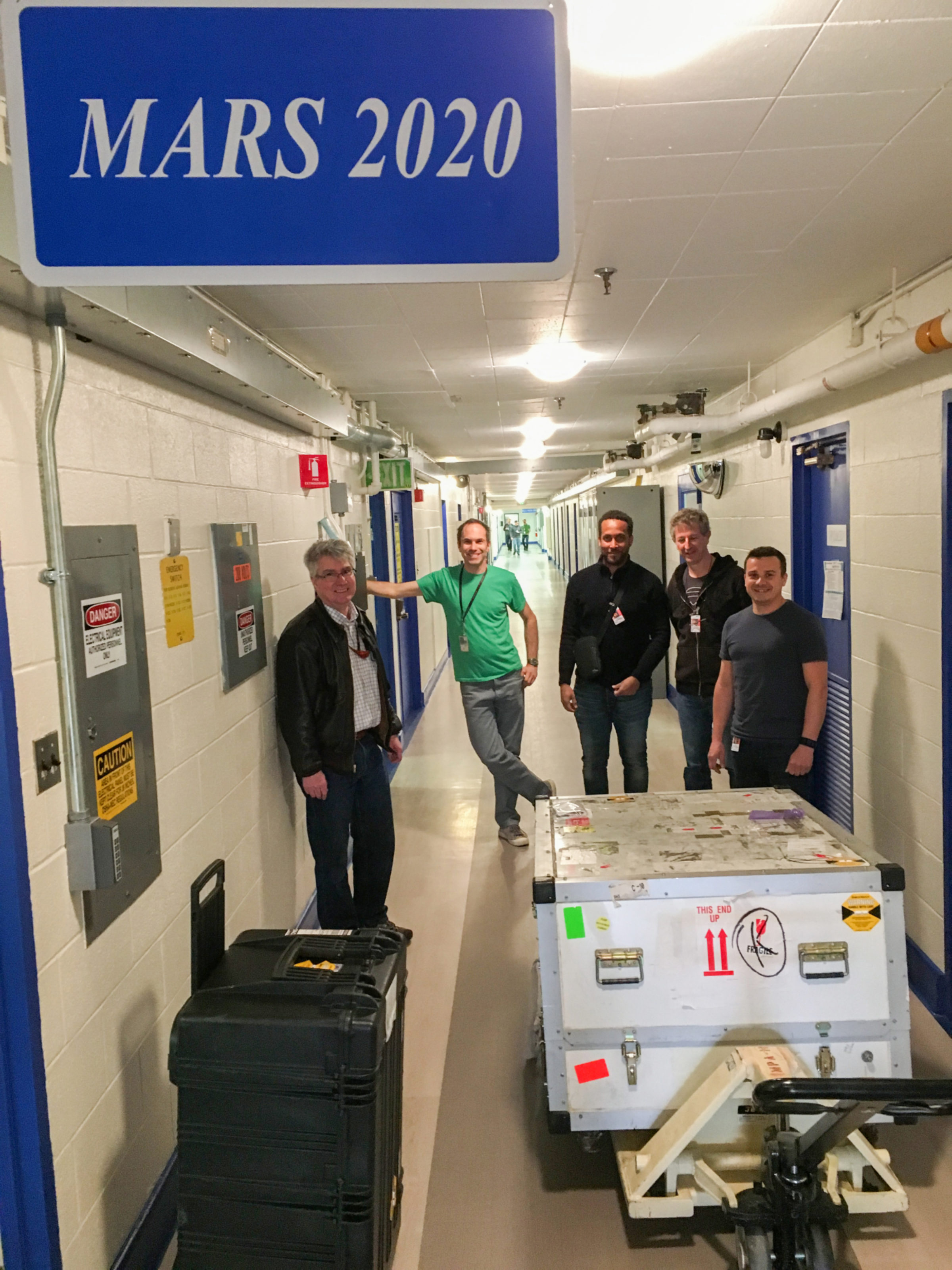Roger Wiens • Apr 27, 2018
‘SuperCam’ Update: Multi-purpose Instrument Coming Together for 2020 Launch to Mars

Excitement is building within the SuperCam team as the instrument enters the final stages of assembly and testing toward an anticipated launch aboard NASA’s Mars 2020 rover. Just this month, the two major parts of an advanced engineering model were delivered and integrated for realistic performance testing.
SuperCam is a souped-up version of ChemCam, which is currently operating aboard the Mars Curiosity rover. ChemCam fires an infrared laser beam at Martian rocks and soils. The beam vaporizes a tiny amount of rock, creating a hot plasma. ChemCam then measures the colors of light in the plasma, which provide clues to the target’s elemental composition. We call the technique laser-induced breakdown spectroscopy (LIBS). A camera provides highly detailed photographs of the laser targets, which also help determine the surface geology.
Sparks from the SuperCam flight laser Sparks are being created 4.85 meters from the SuperCam flight laser at room temperature, which means at low energy. Developed jointly by Los Alamos with the French space agency for NASA's Mars 2020 rover mission, SuperCam combines remote chemistry capabilities and imaging with two mineralogy techniques. With these enhancements over its predecessor ChemCam (now operating on Mars Curiosity rover), SuperCam will be even more capable to study the mineralogy and to detect compounds related to the possibility of life on Mars. SuperCam is also equipped with a microphone to capture the first audio recordings from the red planet. NASA has called SuperCam a “Swiss army knife of instruments” because of its versatility. The laser is manufactured by Thales.Video: IRAP / CNES
ChemCam data has revolutionized our understanding of the geology and atmosphere of Mars. It has measured amounts of elements as rare as lithium and boron while observing more abundant elements in more than half a million spectra sent back from the red planet. Its discoveries have contributed to our current understanding of Mars as a once warmer and more habitable planet.
SuperCam will yield even more detail than ChemCam. Developed jointly by Los Alamos with the French space agency, the instrument is ambitious. It promises to combine the remote chemistry capabilities and imaging of ChemCam with two mineralogy techniques, making it more capable to study the mineralogy and the presence of compounds related to the possibility of life on the surface of Mars. On top of that, it can record sound through a microphone, for the first time on Mars. NASA called it a “Swiss army knife of instruments” because of its versatility.
One of the mineralogy techniques is infrared (IR) spectroscopy. The IR sensor uses light collected by the large (11-centimeter) telescope shared by all of the optical techniques. SuperCam’s IR spectrometer covers the spectral range of 1.3-2.6 microns, known as "short-wave infrared" or "near-infrared" to distinguish it from the longer-wavelength "mid-infrared" or "thermal infrared" ranges (the latter was used on the Mars Exploration Rovers).
Why that spectral range? The near IR can diagnose many of the clay minerals that we anticipate will tell us the history of water on Mars. These minerals absorb light at wavelengths that correspond to vibrational energies of the molecules in the mineral grains. The types of clay minerals and their abundances tell us about the nature of the water that was present, whether fresh or salty, acidic or neutral pH, and whether that water might have been icy or warmer, and whether water was present for a long period of time. These are all critical questions to understand how habitable the environment was, which helps us in our search for organic material that might hint at past biotic activity.
Near-IR spectroscopy has been used extensively from orbit by the CRISM and OMEGA instruments (on the Mars Reconnaissance Orbiter and Mars Express spacecraft, respectively), but this is the first time spectroscopy in this wavelength range will be deployed on Mars’ surface.
LESIA, a French space-sciences research group just outside of Paris, provides the IR spectrometer. The IR spectrometer complements the visible spectroscopy range provided by ChemCam and by SuperCam’s other spectrometers (240-850 nanometers). IR spectroscopy requires a low-noise detector and cold surroundings to maximize the IR light from the target and minimize IR noise from the surrounding material. All room-temperature or warmer surfaces emit in the infrared. Tests at LESIA recently have confirmed the good thermal behavior and low noise of the SuperCam system.

SuperCam's other mineralogy technique is Raman spectroscopy, which uses a laser to stimulate molecules on the surface of a rock or soil. It is a softer, green laser beam than the pulses that blast the surface for LIBS. In the Raman spectroscopy technique, most of the laser light reflects back at the same wavelength that was sent, but a small fraction of the light interacts with the molecules, changing the wavelength in proportion to the vibrational energy of the molecular bonds. By spectrally observing the returned Raman light we can identify the minerals. Raman is complementary to IR spectroscopy, as the two techniques observe different molecular vibrations. Most people think of Raman as an in-situ technique that uses a continuous laser beam, but experts have shown that by using a pulsed laser and image intensifiers, the Raman spectra can be seen some meters away. SuperCam will pioneer this remote Raman technique on Mars.
The Raman technique has proved tricky for SuperCam in a number of ways. The laser beam must be very carefully aligned with the spectrometer’s tiny field of view. At a distance of 10 meters, its field of view is less than a centimeter wide. You might not think that is too difficult to hit with a laser, but the Raman laser beam goes through a periscope with the last mirror mounted in the middle of the SuperCam telescope’s window.

Tests over Mars-like conditions initially showed the beam moving as the window flexed ever so slightly (a few micrometers!) with temperature. Worse, when our French colleagues in Toulouse mechanical-shock tested the telescope to make sure it would survive the whack caused by the firing of rover’s explosive bolts during landing, the beam path moved again. Little by little over the course of the last year, with design improvements and over 50 shock tests, the beam has become more and more stable.
A second challenge was the Raman spectrometer itself. It needed much higher resolution and higher optical efficiency than ChemCam’s spectrometers. Before we even proposed the instrument to NASA we bought and tested image intensifiers built for night-vision goggles. Then we designed a spectrometer around the intensifier to increase the throughput of the returning Raman light. Unfortunately, our first high-resolution design was not high resolution. The lenses and grating were great, as was the detector, but the intensifier itself was lower resolution than we thought. So we spent a year carefully redesigning and rebuilding the spectrometer to make up for the lower resolution of the intensifier, while still giving a high-resolution spectrum. It looked good on paper, but we eagerly anticipated the first full instrument test, which would tell all.

So in early April 2018 we came to the moment of truth: testing the instrument with its components all together. Our French colleagues from the Institute for Astrophysics and Planetary Science in Toulouse sent us the engineering model of the mast unit—the part that sits above the rover. It contains the laser, telescope, high-resolution camera, and IR spectrometer. It arrived at Los Alamos in a huge protective box.

We eagerly but carefully connected it with the spectrometers and electronics built at Los Alamos. We call that the body unit, as it sits in the body of the rover. The two units are connected by electrical cables and an optical fiber that carries the light from the telescope to the spectrometers. A very thin gold layer coats both units to help them maintain their temperatures. We like the shine!

Our first results indicated that the chemistry data from LIBS look even better than ChemCam’s. Moving to the Raman spectroscopy, we now see beautiful, high-resolution Raman spectra. The IR spectrometer and camera have been tested recently in France; they also worked impeccably.

As I write, the flight model is being assembled, with testing and calibration planned for the summer and fall, 2018, before we deliver the instrument to NASA's Jet Propulsion Laboratory for integration on the rover. As we see the fruit of each of these advances, we are more and more excited about the data that will be returned from the SuperCam instrument. It promises to play a key role in exploring a new region of Mars where samples will be collected for potential future return to Earth.
The US contribution to SuperCam is led by the Los Alamos National Laboratory. Other US institutions include USGS, Flagstaff; JPL; Caltech; APL, Johns Hopkins U.; SUNY Stony Brook; U. Hawaii; U. South Carolina; NASA Goddard Space Flight Center; U. Mass. Lowell; U. New Mexico; and SETI Institute. The French contribution to SuperCam is led by CNES and IRAP, Toulouse. Several French institutions contribute to the development of SuperCam, its qualification, and calibration: LESIA, Meudon; LAB, Bordeaux; LATMOS, Guyancourt; ISAE-Supaéro, Toulouse; OMP, Toulouse; IAS, Orsay; CNES Toulouse. Other French laboratories support SuperCam’s analytical techniques, and will participate in due time to the operations on the surface of Mars, as well as data processing: IPAG and ISTerre, Grenoble; IMPMC, Paris; LPGN, Nantes; LGLTPE, Lyon; LOMA, Bordeaux; GeoRessources, Nancy. The Spanish contribution to SuperCam is led by the Univ. of Valladolid. Other Spanish institutions involved in development of the rover calibration targets include U. Basque Country, U. Complutense, and U. Malaga, along with supporting industrial partners. In Denmark, the University of Copenhagen, and in Canada, the University of Winnipeg and McGill University are also contributing.
The Time is Now.
As a Planetary Defender, you’re part of our mission to decrease the risk of Earth being hit by an asteroid or comet.
Donate Today

 Explore Worlds
Explore Worlds Find Life
Find Life Defend Earth
Defend Earth

